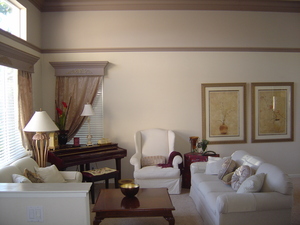Have you ever walked into a builder’s model home and say to yourself that you wish your home would look the same way? You wonder how the colors that you see on the walls and the choices of fabrics, furnishings, etc would look into your home. You want it so bad that you find yourself driving to Home Depot or Lowes looking at different paint swatches, taking a bunch of samples home, but why oh why do you still have your walls in the builder’s white paint it came with years ago? The answer is simple; you do not know exactly where to begin.
The easiest way to achieve these looks is, naturally, to hire a professional interior designer. This option may be the easiest, unfortunately, not cheap. These builders invest an amount of money to get their houses sold. Hiring an interior designer to decorate their model homes pays off because the look and feel of the model homes as they were staged by designers, entice people to buy them. Prospective home owners would imagine themselves living in that kind of setting. Unfortunately later on, when they finally get their keys to their newly built home, aside from being empty, it lacks the character that attracted them enough to buy it in the first place. Of course we all know that a home is not a home unless you have lived in it.
But we want to have our home that look that we can also be proud of. I am not totally nixing the idea of hiring a designer, if you feel that you would rather hire than do it yourself, by all means, hire one. It would certainly eliminate the amount of headaches and saves you time in doing your own research. But for most of us who do not have the extra money to buy brand new furnishings, let alone hire a designer, after putting a huge chunk of the money we saved up for years into our down payment to purchase this “dream home”, hiring a designer is not an option. Owning a home and trying to make it achieve that designer look can turn into a money pit if you are not wise with your choices. Having experienced moving 13 times in the past 14 years that my husband and I had been married, I have learned a few tricks to achieve the model home look. I always go to Model Homes on weekends just to see the latest trends of design, even if I am not buying a home. Model Homes are a good source of inspiration and ideas.
Here are some basic tips in achieving a Model Home look for your home:
1) COLOR – they say the cheapest improvement to update your home is by painting it. It is also the easiest to reverse. For if you make any mistakes or you end up not liking the color, you can always paint over them. You would be amazed at how much a can of paint can do to improve the look of your home. Depending on your taste of design, you would want to start by trying on different hues of paint that you would like to use. Try to use a neutral palette if you are not too sure of what color you want. It is the safest choice. Neutral colors do not have to be boring. You can use different shades of browns, ranging from light taupe to dark caramel without getting too aggressive with the color. I find that getting the bigger color swatch is more beneficial to bring home that those made of small squares. You would like to get 2-3 swatches of varying hues. Stick them on the walls; try to observe them at different times of the day. Colors change in hues throughout the day, depending on the light and dark exposures. When painting and you want to use a two-tone effect commonly used by designers, make sure that the colors compliment each other. Consider also your current furnishings, are they going to blend well with the color of the fabric on your sofa or dining chairs? Some people paint before buying furniture, it is okay if the furniture they really love works well with their wall colors. Oftentimes, especially for discontinued furniture items, you cannot order different upholstery, so you either settle for something else or re-paint if you must have the furniture. So to save time and money, it is always easier to get the furniture first then basing your wall colors on them t than doing it the opposite way.
2) FURNITURE PLACEMENT: a lot of people are constantly challenged ending up in putting sofas against the walls. Although there may be times that this is the best choice, consider placing them flanking or facing the focal point of the room. For example, in the living room, if the focal point is a fireplace, make sure that the furniture placement anchors that focal point. Put sofas and chairs in a conversational way. By this it means that you need to consider entertaining friends and families. Are the chairs and sofas too far apart that having intimate or cozy gatherings impossible to achieve? You would not want to have your guests yelling from across the room just to be in the conversation. Another tip is to make the furniture placements also allow good traffic flow, is it easy for people to go in and out, or is it easy to go from one room to the other. I say this because sometimes people would cluster their furniture too closely that it is impossible to get in and out of. It is a good rule of thumb to have a minimum of 18 inches clearance between sofas and coffee table to allow for knees not to bump into the table yet close enough to be able for a seated person to reach for the items on it.
Dining room placement sometimes is easier than doing the living room. If you have a formal dining room with the regular 4 evenly sized walls then all you need to do is put your dining table and chairs in the middle. If you have a china cabinet or buffet table, make sure it is against the wall that has more space to allow when dining chairs are pulled out that it would not hamper the traffic flow by blocking the path. A good guide here would be your light placement, if your chandelier or light fixture is in the middle, make sure that the table is centered. If you do not have a separate dining room, or you have a so called living room-dining room combination, a good way to have a separation is by placing the sofa as a form of divider, you can either put a sofa table or leave it alone, this an illusion of having two rooms instead of one. Another trick is to use two columns to separate the space or floor to ceiling curtains on each side to give the same visual effect.
Bedroom furniture placement can be another point of some confusion. Make sure that your head board is on the focal point wall. If you have a square room, it is easy to do…but if you have an irregular room, look for the window and door placement. Let those be your guide. Nightstands can flank your bed and table lamps placed on them.
3) LIGHT PLACEMENT: Make sure that you have appropriate lighting in each room. By appropriate it means it should be practical for its use. An office or library should have reading lamps and task lights. A dining room would have a chandelier or center light fixture or wall sconces. The living room can have wall sconces, floor lamps, table lamps for reading. Newer homes sometimes have recessed lighting installed in the living, family room and kitchen to brighten up the areas when entertaining. Bedrooms should have ambient and cozy lighting; conducive to sleeping, so bedside lamps are appropriate in this case.
4) WINDOW COVERINGS: Hang curtains over your window blinds. Some builders provide standard white blinds, some do not. Hanging curtains, whether you have any window blinds or not help in addressing privacy, as well as soften the look of the rooms you’re decorating. Match the colors of your furnishings and wall paint or make sure they compliment each other. Use texture if you are designing in neutrals, so that the room will look more interesting. Some homes have lower ceilings, to give the illusion of height, hang curtains from ceiling to floor. Also if you have a small window, you can give a sense that the window is bigger by hanging the curtains wider than it should, layering curtains with sheer panel underneath can help in achieving this illusion.
5) AREA RUGS: Area rugs can be used to anchor the room. It can beautify the room and anchor the room. I personally do not use area rugs in my home; I’d rather see the beautiful hardwood floors under my table. But area rugs can serve some purpose, aside from adding warmth to the room, it can protect your floors and also it can be used to separate each room, as in the example of living room/dining room combination, you can also use area rugs to define each room.
6) ACCESSORIZE: Now the fun part, accessorizing. Put framed art on the wall; make sure that they are at eye level. Use a leveler to make sure they are not crooked. Use a frame size that is proportionate to the size wall. Do not put a small frame in the middle of a very huge wall. It will look awkward. In the same manner, do not use over-sized frames on a very tiny wall. Be creative in hanging multiple frames on a wall. Use similar color frames, and mattes so that they all match and would be pleasing to the eyes. Make sure to have a unifying theme for the room you are decorating, for example, if you would like to decorate in an Asian theme, this should repeat in the accessories you would use in the entire room. From the throw pillows, flower vases, lamps, etc. As a rule of thumb decorate in threes. Your side table should not be too cluttered; it will just look too busy that one can no longer appreciate the beauty of each collection as there is no resting place for your eyes to go to. Again, do not be afraid to use varying texture to achieve that designer look. Mix things that sparkle with textured items like a ball made of wood. This puts more dimensions to your design.
After you have achieved the look that you are after, enjoy your accomplishment. Be proud to show it off to your friends and families. Give yourself a pat on the back for having done your own design that would soothe your own taste and lifestyle. Another tip in order for your design to look fresh is to change your design every season. It doesn’t mean you have to buy new things all the time or change your wall color, etc. Sometimes replacing a couple of items here and there and replacing with the season can help achieve that fresh look. For example a vase field with spring flowers can be changed to something more summery. Change the throw to something darker and heavier as the weather turns colder. In the same manner, throw pillows can be changed with the season too. Days, months, years will pass and your taste will change from time to time so it would be a good idea to update your design at least every couple of years. One thing is for sure, you will never run out of places to go to for new ideas and inspirations. . Visiting design centers and going to design expos where designers show their craft can help you pick up great ideas. Other sources of ideas would be watching design shows on TV (like TLC, HGTV, DIY), reading books, and going online or reading design magazines. Who knows, you will find your self visiting the new model homes to get inspired once more!




